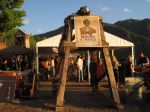PEOPLE’S PALATE WEEKLY WINE RECOMMENDATIONS FOR DECEMBER 26, 2012
LOTS OF BUBBLES TO MAKE YOUR NEW YEAR SPARKLE
Although sparkling wine is always an appropriate choice for any occasion any time of year, no question the New Year, with all its toasts and “Champagne” brunches, are prime time for indulging a bit of bubbly. And effervescent wine is so popular, there are versions made in virtually every wine region.
Champagne
The benchmark for sparkling wine is that made in the Champagne region of northwestern France. Cool climate, limestone laced soils, and a nearly 300 year singular focus on the style (the “traditional method” – secondary fermentation in the bottle to capture the ”stars”) means Champagne is the benchmark for all things foamy. It also means the stuff is quite expensive. So, I suspect in most cases you will be looking for a nonvintage Brut. It’ll still set you back a pretty penny but with a top producer (like the two here) you’ll still get something special.
Charles Heidsieck. One of the oldest and most prestigious Champagne houses, established in 1851, the Charles Heidsieck house style typically is one the most complex and bold. Equal parts pinot noir, chardonnay, pinot meunier, with 40 percent reserve wines – some 10-15 years old – the Brut Reserve ($65) packs toasty brioche, pear and tropical fruits, with nutty notes in an amazingly lush frame. Even given the considerable cash commanded by Champagne, the Brut Reserve delivers a lot of wine for the money.
Lanson. Over 250 years old (the fourth oldest Champagne house), Lanson has been absent from the U.S. market for a while but was recently reintroduced here. Lanson always was one of my favorite Champagnes, so I’m glad they’re back. And the Brut Rosé ($60) doesn’t disappoint. With 53 percent pinot noir, 32 percent chardonnay and 15 percent pinot meunier, the wine is exceedingly fresh and aromatic. This may be because Lanson eschews malolactic fermentation, meaning its wines typically retain more pure fresh fruit character. This one is loaded, with biscuit and floral aromas, red berry and citrus flavors and comes with an elegant texture.
Crémant
Beyond Champagne, there still are a wide variety of (mostly) more affordable choices for you. In France, Crémant is a term used to designate a high quality sparkling wine made using specified quality control practices including the “methode traditionnelle.”
 Pierre Sparr Crémant d’Alsace. The Sparr family winery was established an amazingly long time ago in 1680. Pierre Sparr has access to many of the region’s finest vineyards, so maybe it shouldn’t be a surprise this is a highly respected producer. The Brut Reserve ($19) is 80 percent pinot blanc, 20 percent pinot auxerrois. The nose suggests the assertive melon, tropical and citrus fruit that dominates the palate. Fine mousse tickles the palate with minerals and hints of nuts. A fantastic value. The Brut Rosé ($19) is 100 percent pinot noir with fresh aromas of soft red berries and delicate, fruity flavors and lively acidity.
Pierre Sparr Crémant d’Alsace. The Sparr family winery was established an amazingly long time ago in 1680. Pierre Sparr has access to many of the region’s finest vineyards, so maybe it shouldn’t be a surprise this is a highly respected producer. The Brut Reserve ($19) is 80 percent pinot blanc, 20 percent pinot auxerrois. The nose suggests the assertive melon, tropical and citrus fruit that dominates the palate. Fine mousse tickles the palate with minerals and hints of nuts. A fantastic value. The Brut Rosé ($19) is 100 percent pinot noir with fresh aromas of soft red berries and delicate, fruity flavors and lively acidity.
Gerard Bertrand Crémant de Limoux. Limoux, a small town and appellation in the Languedoc-Rousillon  region of Mediterranean France, lays claim to producing sparkling wine by a second fermentation in the bottle long before Champagne. Crémant de Limoux traces its history to 1531 and Benedictine monks at the abbey of Saint-Hilaire. Bertrand’s 2010 Crémant de Limoux ($16) is a blend of 70 percent chardonnay, 20 percent chenin blanc and 10 percent mauzac, the indigenous grape which used to dominate all Limoux sparkling wine. There is enticing flowery, citrus and toast on the nose and pleasant pear, apple and lemon flavors. I found the palate to show refined, frothy bubbles.
region of Mediterranean France, lays claim to producing sparkling wine by a second fermentation in the bottle long before Champagne. Crémant de Limoux traces its history to 1531 and Benedictine monks at the abbey of Saint-Hilaire. Bertrand’s 2010 Crémant de Limoux ($16) is a blend of 70 percent chardonnay, 20 percent chenin blanc and 10 percent mauzac, the indigenous grape which used to dominate all Limoux sparkling wine. There is enticing flowery, citrus and toast on the nose and pleasant pear, apple and lemon flavors. I found the palate to show refined, frothy bubbles.
Prosecco
Prosecco from the Veneto region of northeastern Italy has become an extremely popular sparkling wine choice in recent years. Prosecco (the name of the production zone, while glera is the dominant grape), unlike the other sparklers in this report is produced using the Charmat Method. In this case, the bubbles are produced by inducing the second fermentation in a pressurized tank. The attraction is in fresh aromas and clean, delicate fruit, frizzante bubbles and low alcohol.
 Valdo. Valdo Spumanti was established in 1926 and has been owned by the Bolla family since 1940. The Valdo Brut DOC ($12) opens with floral aromas and delivers lively, fruity pear and apple flavors. Valdo also has released a new Prosecco Superiore DOCG Brut. Designated “Oro Puro” ($16), Prosecco’s fresh, lively style certainly is present but there is evidence of greater complexity and fuller flavors as the grapes are from the finest (usually higher altitude) hillside estate vineyards and the wine undergoes an extended aging period. Also consider Valdo’s Nerello Mascalese Rosé ($14), in which the nerello grape adds color, raspberry and spice to the blend. It’s not Prosecco but is similar in style.
Valdo. Valdo Spumanti was established in 1926 and has been owned by the Bolla family since 1940. The Valdo Brut DOC ($12) opens with floral aromas and delivers lively, fruity pear and apple flavors. Valdo also has released a new Prosecco Superiore DOCG Brut. Designated “Oro Puro” ($16), Prosecco’s fresh, lively style certainly is present but there is evidence of greater complexity and fuller flavors as the grapes are from the finest (usually higher altitude) hillside estate vineyards and the wine undergoes an extended aging period. Also consider Valdo’s Nerello Mascalese Rosé ($14), in which the nerello grape adds color, raspberry and spice to the blend. It’s not Prosecco but is similar in style.

 Mionetto. Another one of Prosecco’s top producers, Mionetto traces its origin to 1887. They also areone of the zone’s most creative, as evidenced by the lighter, gently-sparkling and lower alcohol style of Mionetto’s “IL” ($13). The fruity aroma of pear and citrus is followed by a fresh and crisp wine with apple and peach flavors. The Mionetto Prosecco Brut DOC Treviso ($15) is a bit floral and more intensely fruity with notes of apple and citrus. It also is drier and pleasantly brisk.
Mionetto. Another one of Prosecco’s top producers, Mionetto traces its origin to 1887. They also areone of the zone’s most creative, as evidenced by the lighter, gently-sparkling and lower alcohol style of Mionetto’s “IL” ($13). The fruity aroma of pear and citrus is followed by a fresh and crisp wine with apple and peach flavors. The Mionetto Prosecco Brut DOC Treviso ($15) is a bit floral and more intensely fruity with notes of apple and citrus. It also is drier and pleasantly brisk.
Enza. Enza Extra Dry ($15) is a new brand produced for the importer W.J. Deutsch by the Cantina Colli del Soligo, a cooperative of growers throughout the Veneto. The slightly higher residual sugar is nicely balanced with just the right touch of acidity. The delicate bouquet offers with scents of pear and apple with a lightly floral, while the mouth also exhibits citrus and peach.
Moscato and Moscato d’Asti
You have to give the Italians credit for creativity and their fascination with spumante. As much as they are rightly recognized for their red wines, I have been told the Italians are just as proud of their sparkling wines. In addition to Prosecco and the impressive Franciacorta (none reviewed here), the Piemontese have come up with one of the most delightful of all. Made from the moscato bianco (white Muscat) grape in the vineyards surrounding the town of Asti, moscato d’Asti is enticingly aromatic, delightfully sweet, slightly fizzy (frizzante), and very low alcohol (5.5%), making it perfect as an aperitif or a dessert wine.
 Vietti Moscato d’Asti. With a 200 year tradition of winemaking, this highly regarded producer
Vietti Moscato d’Asti. With a 200 year tradition of winemaking, this highly regarded producer  is recognized as one of the first in the Piemonte to bottle single-vineyard wines and for pioneering the resurrection of the indigenous areneis white grape. They also make one of the best Moscato d’Asti. The 2012 “Cascinetta” ($15) uses only the best moscato grapes with extended maturation. The resulting wine intense aromas of honey, peach and orange, with hints of spice and a suggestion of flowers. On the palate, it is loaded with apple, pear and lemon, while its delicate sweetness is balanced with bracing acidity leading to a fresh finish.
is recognized as one of the first in the Piemonte to bottle single-vineyard wines and for pioneering the resurrection of the indigenous areneis white grape. They also make one of the best Moscato d’Asti. The 2012 “Cascinetta” ($15) uses only the best moscato grapes with extended maturation. The resulting wine intense aromas of honey, peach and orange, with hints of spice and a suggestion of flowers. On the palate, it is loaded with apple, pear and lemon, while its delicate sweetness is balanced with bracing acidity leading to a fresh finish.
Caposaldo Moscato. Caposaldo is a brand brought to the U.S. by the importer Kobrand. The Moscato IGT ($10) actually is not a Moscato d’Asti but I include it here for ease of reference. The grapes are grown in the Provincia di Pavia in northern Italy’s Lombardy region. It is a bit less sweet and higher in alcohol (but still very low at 7%). And the price sure is right.
Cava
Spanish Cava has long been my go-to bubbly for parties and friendly accompaniment for meals. Most Cava is produced by the tradition method in the Penedès valley in Cataluna not far from Barcelona. Most Cava features the indigenous grapes Macabeo, Xarel-lo, Parellada. It’s recently had competition from Prosecco but is still a great choice.
![]() Codorníu. Codorníu has been a premier sparkling wine producer since 1872 when the family introduced the traditional method to Spain. The family’s winemaking history actually stretches back more than 450 years to 1551. Anna de Codorníu Brut ($15) celebrates the life of Codorníu’s last heiress and the family she guided. It was the first Cava to use chardonnay in its cuvee, 70 percent in this release with 30 percent parellada. It shows some richness and a little sweetness, with a solid structure and a creamy texture and more fruit than expected – citrus, tropical and strawberry aromas; and apple, citrus, and raspberry flavors.
Codorníu. Codorníu has been a premier sparkling wine producer since 1872 when the family introduced the traditional method to Spain. The family’s winemaking history actually stretches back more than 450 years to 1551. Anna de Codorníu Brut ($15) celebrates the life of Codorníu’s last heiress and the family she guided. It was the first Cava to use chardonnay in its cuvee, 70 percent in this release with 30 percent parellada. It shows some richness and a little sweetness, with a solid structure and a creamy texture and more fruit than expected – citrus, tropical and strawberry aromas; and apple, citrus, and raspberry flavors.
 Poema. Poema is a top-quality, small-production Cava house that emphasizes sustainable practices, suchasorganic fertilizer and no herbicides. The Brut ($13) is notable for its fresh bread, citrus, apple and even mineral notes. Its crisp, fruity and well-balanced profile positions it as a great choice.
Poema. Poema is a top-quality, small-production Cava house that emphasizes sustainable practices, suchasorganic fertilizer and no herbicides. The Brut ($13) is notable for its fresh bread, citrus, apple and even mineral notes. Its crisp, fruity and well-balanced profile positions it as a great choice. California
 Barefoot Bubbly. For my California selection, I’m recommending a reliable choice in the so-called “value” category – Barefoot Bubbly. Barefoot Cellars has been churning out good value wines since 1986. Today, they produce thirteen still wines and seven sparkling. The mainstays of the Barefoot Bubbly line are the Brut Cuvée and Extra Dry, each ($11). The Brut is not as dry as the term usually indicates. But it is clean and crisp, with nice lemon and apple fruit balanced with creamy notes. The Extra Dry shows nice fresh tropical fruit; it is slightly sweet but finishes with refreshing acidity. These wines are ideal for parties and family gatherings and make a good base for the ever popular mimosa.
Barefoot Bubbly. For my California selection, I’m recommending a reliable choice in the so-called “value” category – Barefoot Bubbly. Barefoot Cellars has been churning out good value wines since 1986. Today, they produce thirteen still wines and seven sparkling. The mainstays of the Barefoot Bubbly line are the Brut Cuvée and Extra Dry, each ($11). The Brut is not as dry as the term usually indicates. But it is clean and crisp, with nice lemon and apple fruit balanced with creamy notes. The Extra Dry shows nice fresh tropical fruit; it is slightly sweet but finishes with refreshing acidity. These wines are ideal for parties and family gatherings and make a good base for the ever popular mimosa.







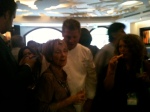
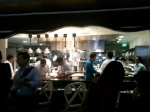
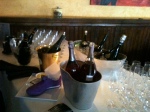 Next, it was off to Jimmy’s restaurant for a casual dinner hosted by Ferrer Wine Estates and featuringsome of their fine sparklers. While visiting with Eva Bertran, Executive Vice President at Freixenet USA, I enjoyed the Segura Viudas Reserva Heredad ($20) and Freixenet ElyssiaPinotNoir Brut from their extensive line of Cava. I also enjoyed talking and and tasting with Gloria Ferrer (the family’s California winery) winemaker Bob Iantosca. His limited release 2005 Anniversary Cuvee ($45) was especially complex and flavorful.
Next, it was off to Jimmy’s restaurant for a casual dinner hosted by Ferrer Wine Estates and featuringsome of their fine sparklers. While visiting with Eva Bertran, Executive Vice President at Freixenet USA, I enjoyed the Segura Viudas Reserva Heredad ($20) and Freixenet ElyssiaPinotNoir Brut from their extensive line of Cava. I also enjoyed talking and and tasting with Gloria Ferrer (the family’s California winery) winemaker Bob Iantosca. His limited release 2005 Anniversary Cuvee ($45) was especially complex and flavorful.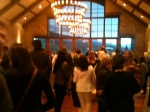 chef Jose Andres. Besidesgreat food, the event featured too many Spanish wines to taste them all or even keep tasting notes but I was impressed enough with the 2006 Bodegas Muga Reserva Seleccion ($40) to write it down in my notesand recommend it here. And that was just the first night! Friday night upped the ante.
chef Jose Andres. Besidesgreat food, the event featured too many Spanish wines to taste them all or even keep tasting notes but I was impressed enough with the 2006 Bodegas Muga Reserva Seleccion ($40) to write it down in my notesand recommend it here. And that was just the first night! Friday night upped the ante.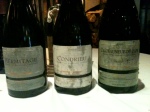 At a reception hosted by importer Wilson Daniels, the array of fine winesfrom their international portfolio was truly impressive. I felt like a kid in a candy store, as there were numerous wines that impacted me, from white Burgundy (Leflaive 2008 Pulighy-Montrachet, Laroche 2009 Reserve de l’Obedience Chablis Grand Cru and 2009 Petite Chablis) and Rhone Valley whites (Tardieu Laurent 2007 Hermitage, 2009 Condrieu and 2007 Chateauneuf-du-Pape) to Barbaresco (2005 Ceretto Bricco Asili), Tokaji Aszu (1999 Royal Tokaji 6 Puttanyos), and California Cabernet Sauvignion (2008 Lancaster Estate). Whew!
At a reception hosted by importer Wilson Daniels, the array of fine winesfrom their international portfolio was truly impressive. I felt like a kid in a candy store, as there were numerous wines that impacted me, from white Burgundy (Leflaive 2008 Pulighy-Montrachet, Laroche 2009 Reserve de l’Obedience Chablis Grand Cru and 2009 Petite Chablis) and Rhone Valley whites (Tardieu Laurent 2007 Hermitage, 2009 Condrieu and 2007 Chateauneuf-du-Pape) to Barbaresco (2005 Ceretto Bricco Asili), Tokaji Aszu (1999 Royal Tokaji 6 Puttanyos), and California Cabernet Sauvignion (2008 Lancaster Estate). Whew!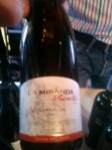 delectables with fine wines from Portuguese winery Esporao. My favorite at thistasting was the 2009 Esporao Reserva ($20), an enticing blend of indigenous and international varieties.
delectables with fine wines from Portuguese winery Esporao. My favorite at thistasting was the 2009 Esporao Reserva ($20), an enticing blend of indigenous and international varieties.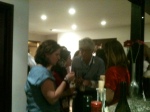

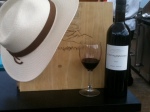 USA.This tasting featured just one wine, and an Argentinean wine at that: the 2007 Cheval des Andes ($80). This wine, a joint venture between Terrazas de Los Andes and Chateau Cheval Blanc, blends cabernet sauvignon, malbec and petite verdot into a wine that rivals the best of Bordeaux. It was so special it seemed perfectly appropriate that it was the only one at the tasting.
USA.This tasting featured just one wine, and an Argentinean wine at that: the 2007 Cheval des Andes ($80). This wine, a joint venture between Terrazas de Los Andes and Chateau Cheval Blanc, blends cabernet sauvignon, malbec and petite verdot into a wine that rivals the best of Bordeaux. It was so special it seemed perfectly appropriate that it was the only one at the tasting. Then it was to the reprise of the Kobrand happy hour. And what a treat it was to have a chance to taste many of the great Lousi Jadot Burgundies, wines even wine writers seldom get to taste. Just look at this line up! 1978 Chevalier Montrachet les Demoiselles1978 Bonnes Mares 1985 Gevrey Chambertin Clos St. Jacques 1986 Batard Montrachet 1989 Vosne Romanee Suchots 1990 Chambertin Clos de Beze 1991 Corton Charlemagne 1996 Beaune Greves 1996 Corton Pougets 1999 Meursault Genevrieres.
Then it was to the reprise of the Kobrand happy hour. And what a treat it was to have a chance to taste many of the great Lousi Jadot Burgundies, wines even wine writers seldom get to taste. Just look at this line up! 1978 Chevalier Montrachet les Demoiselles1978 Bonnes Mares 1985 Gevrey Chambertin Clos St. Jacques 1986 Batard Montrachet 1989 Vosne Romanee Suchots 1990 Chambertin Clos de Beze 1991 Corton Charlemagne 1996 Beaune Greves 1996 Corton Pougets 1999 Meursault Genevrieres.